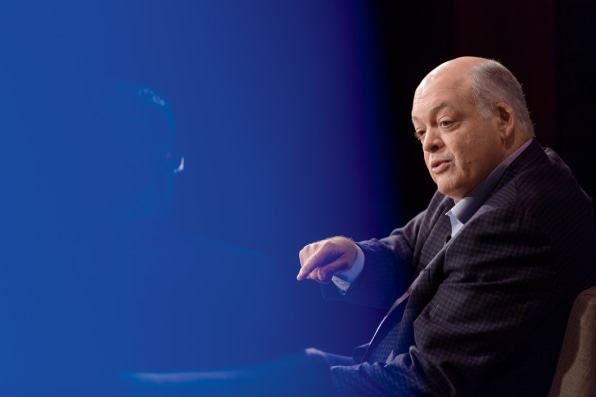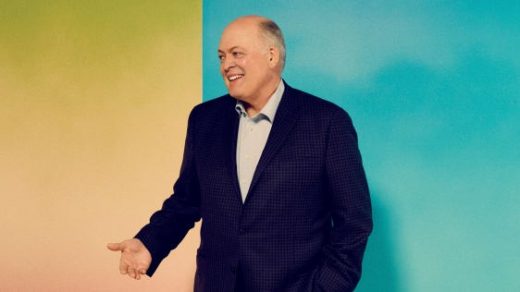Ford CEO Jim Hackett On The Future Of Car Ownership And Driving
More than a century ago, Ford Motor Co. made the automobile a mass-market consumer product accessible to all. Last May, Jim Hackett took over as the company’s CEO and faced a challenge as big as anything Henry Ford ever encountered: to lead the company into a future defined by autonomous vehicles, clean fuel alternatives, and the concept of mobility as a tech-driven mobile service. Hackett talks to Fast Company’s Robert Safian about the need for agility and how it’s shaping his plans to recast Ford’s business model and culture.
Fast Company: You were previously the CEO of another company, Steelcase, which went through some transitions and culture changes. This is a different kind of spotlight.
Jim Hackett: I had this interim assignment as the University of Michigan athletic director where I hired [former star quarterback] Jim Harbaugh as head football coach, so that spotlight was big.
FC: You don’t mind the spotlight?
JH: It’s not painful, [but] I don’t seek it. It feeds some of the wrong things about the way people think of business. The cult of personality as a CEO, there are some people who can pull that off. Very few. I would rather be in the background and be known as a person who’s thoughtful, whom people love to work for, and then the team is in the spotlight. It is the way I was wired, with three older brothers. Roger Enrico, who helped lead Pepsi [from 1983 to 2003], said that leadership is having a point of view. The CEO can’t shrink from that. If you do, the company suffers from confusion, lack of direction. So in my first hundred days [as Ford CEO], we have developed a point of view of the future of the company: “smart vehicles in a smart world.”
FC: “A smart world”–the environment outside–you don’t have as much control over that, do you?
JH: The evolution of the environment is not only needed but is going to happen. For instance, you waste more time today trying to find a parking place than being stuck in traffic. Now, that’s just [about] trying to match the open parking place with where the car needs to go, which is going to help fuel efficiency, whether it’s electric or gas. It’s a “smart vehicle, smart environment, smart world” kind of example.
People have to be mobile. We already know factions are discriminated against because they’re old and can’t get to a doctor, or they’re in a certain part of the city and they don’t have enough money, or they can’t get to the bus stop and it’s cold. Mobility has to be, as [Ford executive chairman] Bill Ford says, a fundamental human right. It’s something that we have to stand for.
There’s a myth in the press that people are going to give up their vehicles. It’s an object that sits 90% of the time and you borrow money to pay for it. What’s the psychology of that? We do it because [cars] give a sense of control, independence, and freedom. In the future, that will matter too.
As we build this smart world, we think we can have you vacillate between different kinds of mobile systems depending on what you want. You can have an ownership kind of feeling, and you can have a Chariot, which is the [ride-sharing] brand we’ve started in northern California. It’s 70% occupied by women every day. Why? They feel safe opting into this transport system. There’s 6 to 10 riders in it. You hail it with your phone, and it plots its path based on where the crowd wants to go. That’s mobility you won’t buy through a car dealer. But we will need car dealers in the future for autonomous vehicles, too.
FC: What’s Ford’s competitive advantage in this battle for the future of mobility?
JH: It’s this blue oval. When I joined the board, I got letters from my friends in business and the opening sentence in all of them was, “Jim, in 2008, when Ford didn’t take the money, I bought a Ford.” The sentiment was, you know, one for the good guys here. I’m not diminishing the other companies [that participated in the government bailout of the auto industry]. It was good for the world that those companies survived. But this team of people that ran the company kept it alive.
There are very few auto companies where there’s a family presence. You can’t believe the advantage. It’s a pixie dust in the values of the company, because family owners have a long-arc view of who they want to be. Bill Ford, whose great-grandfather started the company, told the world that cars can’t continue to operate the way they have been, because we’ll kill the world if China just cuts and pastes what we do. I am proud of working with a group of people who stand for those kinds of things. We didn’t take the [bailout] money, we care about the environment, we think mobility is a basic human right.
FC: What about Tesla? Is its model the one that automakers aspire to, even if they don’t necessarily aspire to be that brand?
JH: Who is that? [Laughs] If you’ve run a big company, enterprise computing is the underpinning of how something gets built. If you’re Tesla and you’re starting the company, you go and seek somebody who has a made-for-enterprise system: low cost, simple, and you’re going to make one product. So there is a pure genius running the company, but it isn’t the genius that drove that; it’s the economics. It’s also the waste at Ford that caused it to not evolve in that regard. That’s something I want to fix: You should have no advantage ordering your Tesla versus ordering your Ford. Ford’s not stupid. It’s not that they don’t get it. It’s the weight of that [older] enterprise system. That’s the area where disruption sneaks in, and I call it a thief in the night. It steals your livelihood.

[Photo: Celine Grouard]
What Tesla proved to us is that the next gen of propulsion, electrification—customers love it. But there is not one company in the world, we think, that makes pure profit on electrification. Tesla doesn’t. The investors are happy, though, because they see 500,000 orders for a new vehicle. That’s a confirmation of consumption.
We’re the number-two company in the industry in non-internal combustion engines. We use hybrid and electrification. In October, we went to Wall Street and said, “Look, propulsion is a frame, the way a designer would think in the future. It doesn’t mean that electrification’s won the war for the next thousand years, right? Hydrogen’s there, there are all kinds of things.” Ford is committed to propulsion platforms that are beyond gas, that have zero emissions, that are kind to the planet. But our customers have to come with us. Right now, electrification represents 5% of the total sales of vehicles. If you wanted to put a car in your garage and charge it, your electrician may have to come in and install some kind of alternative capacity. These are things that the disruption didn’t address well. You can go to a gas station on every corner, the price is lower than in history, and [Ford’s] F-150 now gets 23 miles per gallon.
FC: How do you respond to the critique that climate change and the environment are not as important to car companies because they’re selling so many trucks and SUVs as opposed to electric vehicles?
JH: Well, you can have it all. That’s the new message. The way Ford got the F-150 from 8 miles per gallon to 23 is because three years ago the company made the single-largest investment ever in a transformation of an auto factory, changing the underpinnings [of the vehicle] from steel to aluminum. We had a CEO at the time who was a brilliant aerospace engineer, Al Mulally, so he knew how airplanes were built. It’s a big challenge to put the body panels and that aluminum together. [You] don’t just put a screw in them and they hold.
The Ford advantage is that we know what people love about their cars. Tesla is getting some love. I don’t want to discredit them. But these platforms that they build on use what’s called a skateboard—that’s where all the battery structure is—and that’s limited what could be built on top of it cost-effectively. We’re working on different ways to pack batteries and store energy so you can have the vehicle that you love. Mustang, for example, is the number-one sports car in Europe. Can we marry the propulsion systems of the future with the passion people have for their trucks and cars? Of course.
FC: What will be the biggest obstacle to change at Ford five years from now?
JH: Regulations. I’m really proud that governments all over the world are making way for autonomy. They’re not holding back the evolution of it. But regulations have got to stay apace. Regulations that used to protect the way people were elected fairly haven’t caught up with the new technologies. That’s the same problem we’re going to have in vehicles.
FC: As you lead Ford forward into this murky future, how do you stay positive?
JH: Oh, my goodness. Well, you start with having a great father. We didn’t need an alarm clock. Every day, he woke us up. I don’t mean, “It’s time to get up!” I mean, his singing and the noise and the optimism, it just flowed through our home. I come to work every day with this sense that there’s something I’m going to learn. I’m optimistic about the way the world’s evolving, and Ford’s role in that.
This story was adapted from the Fast Company Innovation Festival.
Fast Company , Read Full Story
(24)



